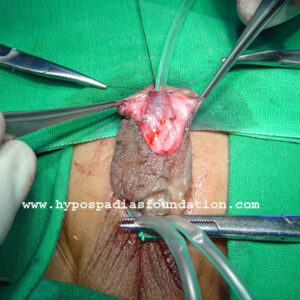Master R.S., 4 years old boy had hypospadias repair elsewhere at 2 years of age. From the previous records it was a proximal penile hypospadias. After repair there was a distal dehiscence- the repair at the end had given way and also he was passing urine from an opening at the site of previous hypospadias- urethral fistula. On examination we can see that the opening for the urethra is much below the tip of penis and there is a fistula near the base of penis.
A metal based flap was devised which was flipped to make the terminal part of urethra. At the same time- fistula was closed after wide mobilisation of flaps, excision of track and multilayered tension free closure. Catheter was left for 7 days. Post-operative result was very good with no fistula and the child is passing urine in good stream.

Clinical picture showing distally open tip of penis with inadequate repair and a proximal fistula

A meatal based flap has been isolated and raise for flipping it to make a neourethra

Flap has been flipped to make the neourethra

Glans repair has been finished and now fistula repair is going on.
Dr Singal and Dr Dubey have an extensive experience in dealing with re-operative hypospadias who have failed surgery elsewhere. The various innovative techniques used are:
1. Parameatal flap
2. Transverse island flaps from nearby skin
3. Dorsal flaps rotated ventrally
4. Buccal mucosal patches/ grafts
Even in the face of falied multiple surgeries, an attempt is made to repair with a single stage flap surgery. Sometimes when the tissues are really scarred and unhealthy, a staged repair is offered which includes excision of the unhealthy tissue in first stage with buccal mucosa grafting and then tubularisation in the second stage.
